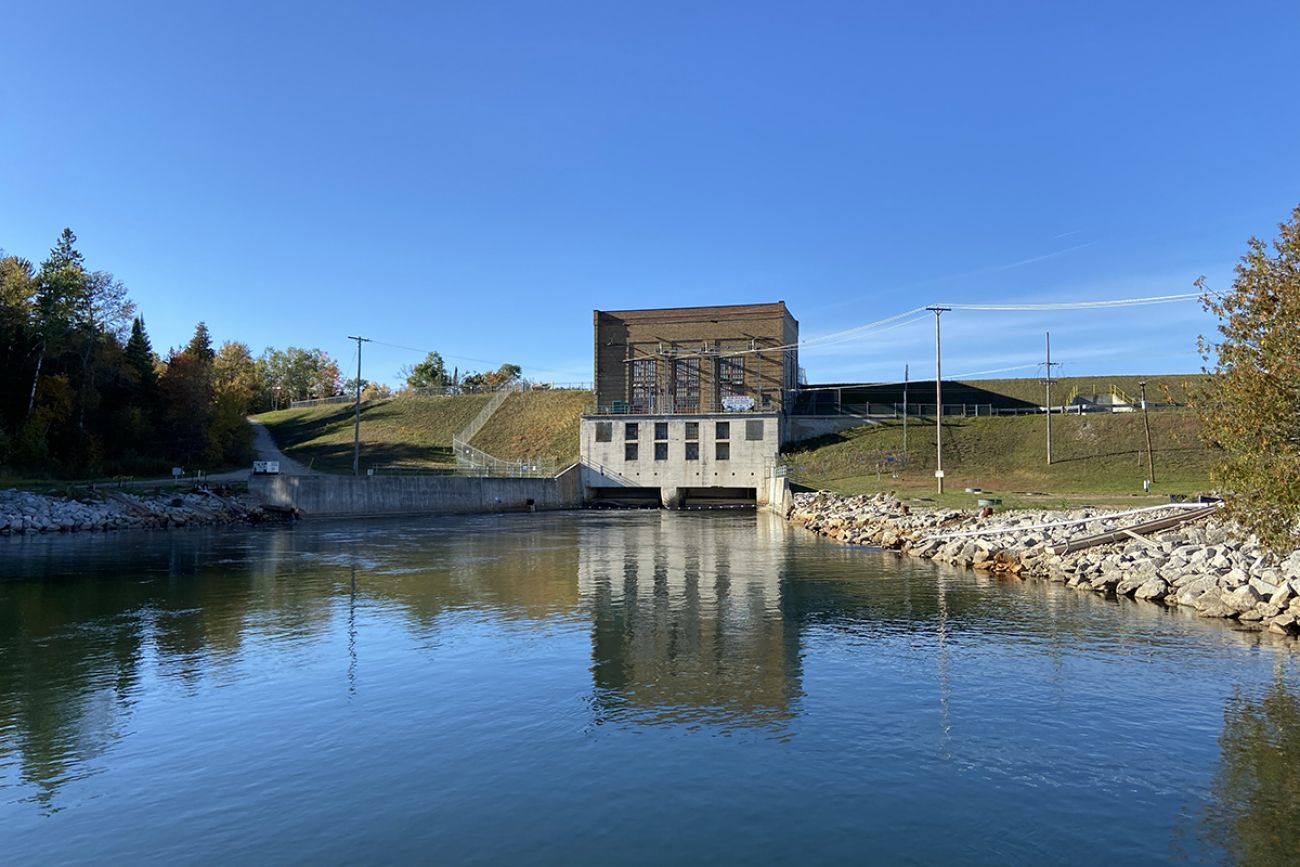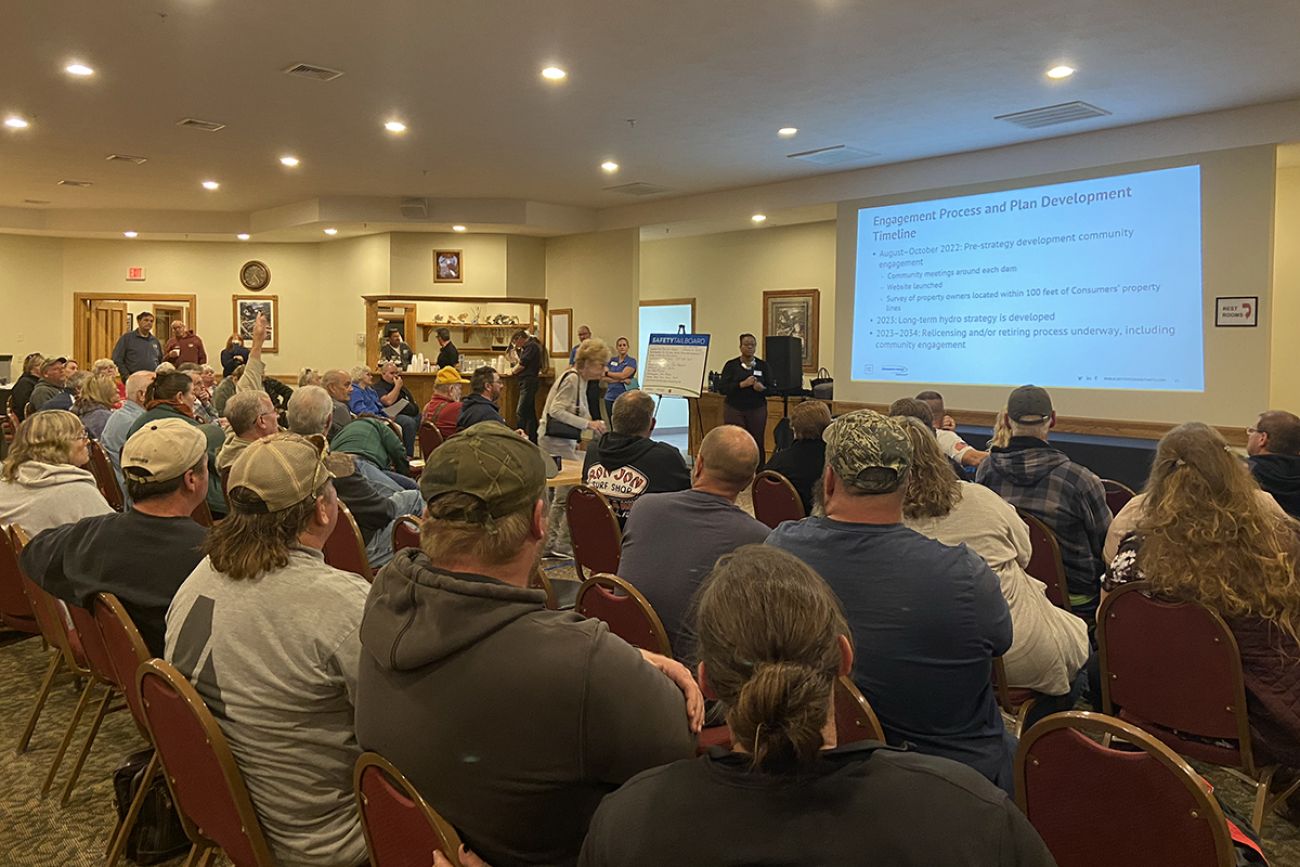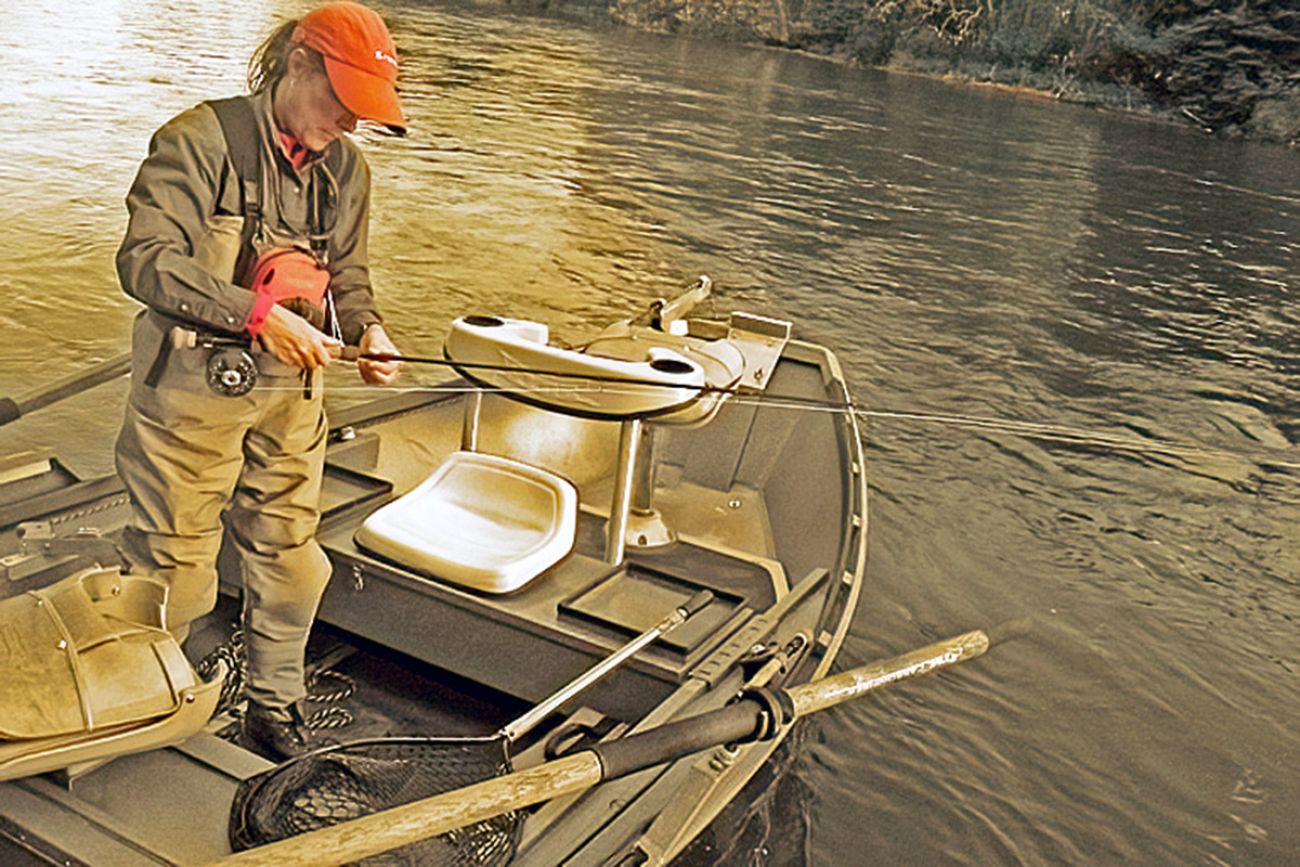Uncertainty for Michigan rivers, residents as Consumers reconsiders its 13 dams

- Consumers Energy is considering whether to keep its 13 hydropower dams on Michigan rivers
- The dams are environmentally and financially costly, and deliver little energy. But their reservoirs are beloved for recreation
- The outcome could dramatically alter Michigan’s rivers and surrounding communities
GLENNIE — Just west of this tiny town near Oscoda sits one of six hydroelectric dams that tamed the Au Sable River a century ago to supply power to a growing population.
At the time, before policy had caught up to the environmental consequences of dams, the impoundments seemed like miracle assets, delivering emissions-free power as reliably as a river flows. The ponds they created became destinations for boating, swimming and fishing, fueling tourism in a part of the state with limited jobs.
But fast forward a century, and the same structures have become expensive, environmentally costly assets that deliver negligible amounts of power at a premium price.
Related:
- Two years after Midland dam failures, still no action on safety reforms
- Michigan stuck with $200M tab to fix Midland dams neglected by owners
- Michigan dams need ‘immediate attention’ to prevent next failure
- Traverse City’s FishPass dam replacement project OK’d by appeals court
Their owner, Consumers Energy, has begun to ask whether their existence still makes sense.
All of which lead Tonya Wertheimer to wonder: If the Alcona Dam were to disappear tomorrow, taking with it the 1,075-acre reservoir that draws tourists all summer long, would Glennie’s grocery store be next?
“Where are we gonna buy our bread?” the 67-year-old resident said through tears at a recent public meeting hosted by Consumers. “Where are the people that actually live here, where is this community going to survive?”

Consumers, one of Michigan’s largest electric utilities, began a lengthy process this autumn to consider the future of its 13 hydropower dams that plug five Michigan rivers: The Au Sable, Manistee, Muskegon, Grand and Kalamazoo.
At issue is whether to keep the impoundments in place, or remove them. The decision has more potential to alter Michigan’s rivers and the communities that surround them than perhaps any action since their construction stopped up the rivers and inundated a collective 17,200 surrounding acres with water that people built lives and livelihoods around.
While the company is years from making a decision, its deliberations are drawing keen interest from nearby residents who fear lost property values and dying towns, from electric ratepayer advocates wary of the high costs to maintain dams that deliver little power, and from environmentalists who see a once-in-a-lifetime chance to restore rivers harmed by the impoundments.
Boom to bust
During hydropower’s heyday, Consumers and its predecessors owned more than 90 dams across the state.
The structures generate electricity by stopping up rivers, flooding the land behind the dams and then releasing that water through the dam, where the force of its flow spins turbines to power a generator.
For much of the last century, it was a cheap and reliable form of energy. But its massive environmental tradeoffs quickly became clear. The dams fragmented rivers and warmed their water, harming fish. Fluctuations to rivers’ flow from the fillup and drawdown of reservoirs interrupted natural rhythms that guide many river species’ reproduction and growth cycles. And sediments became trapped in reservoirs, starving the river downstream while causing the ponds to fill with silt.
“It’s not best for the river,” said Tess Nelkie, board secretary of fishing and river conservation group Anglers of the Au Sable. “And it’s not best for everything that lives in the river.”

Over time, the economics of power generation shifted, too. New regulations ended the practice of “peaking,” or filling and then rapidly draining reservoirs to maximize power output during times of high demand. As a result, the dams now operate at less than 40 percent of their capacity.
And cheaper energy sources entered the fray while the aging dams became increasingly expensive to operate and maintain.
Today, “it’s one of the more expensive power sources we provide,” said Adam Monroe, Consumers’ executive director of hydro operations. Wind, for example, is 31 times cheaper.
Amid those changes, Consumers sold or retired most of its dams between the 1940s and 1970s. The 13 that remain provide just 1.2 percent of the utility’s annual power mix, barely enough to cover their $12.6 million in annual operating costs.
And at an average of 105 years old, Consumers says the dams need hundreds of millions of dollars in maintenance and upgrades to continue operating safely.
The company’s dilemma is familiar: More than 80 percent of Michigan’s 2,521 dams have aged beyond their intended life span, resulting in growing costs to keep them going. Hydropower’s waning cost-competitiveness at times leaves dam owners struggling to cover those costs.
Those imbalances played out dramatically in 2020, when two privately-owned Midland area dams failed amid heavy rainfall. Regulators for years had flagged safety issues at the dams, but Boyce Hydro insisted it lacked the money to make fixes.
Following the disaster, a state task force concluded that dams across the state need “immediate attention” to avoid future tragedies, including money to fix problem dams and “substantially enhance dam removal.”
Federal regulators consider Consumers' dams to be in satisfactory condition, with none of the alarming deficiencies that plagued the Midland dams. But licenses for 11 of the 13 dams will expire in 2034, putting the company on a timeline to decide whether it’s logical to make the investments needed to keep them safe for the future.
Consumers is considering one of four options for each dam: Relicense and continue generating power; sell to a new owner who would maintain the impoundment; remove the dam and restore a free-flowing river; or build a new barrier that generates no power, but preserves a reservoir.
Consumers plans to announce its preferred solution for each of the 13 dams next year. After that, state and federal regulators will decide whether the company can move forward with its plans.
Good for tourism, bad for fish
The idea of losing the dams has nearby residents nervous.
On the Kalamazoo River, hundreds of residents who live on the reservoir created by the Calkins Bridge Dam have joined a property owners’ association that is lobbying for its survival. On the Au Sable, a Facebook group has cropped up devoted to saving the dams.
And across the state, large crowds showed up at public meetings with Consumers to voice their fears about the future.
“All of these communities are dependent on waterways that are created out of those dams,” said Coco Soodek, president of the Lake Allegan Association, which represents landowners on the impoundment created by the Calkins Bridge Dam, near Allegan in the Kalamazoo River. “And the communities that surround those bodies of water would be destroyed.”
Those efforts are met with counterpoints from environmentalists who see Consumers’ process as a rare opportunity to undo the environmental impacts of dams, which have thwarted the survival of migratory fish and other river life.
Take, for example, the Muskegon River, where migratory native lake sturgeon once had free reign of the 219-mile river from Lake Michigan to Higgins Lake. Now, the massive ancient fish can go a few dozen miles before a concrete wall blocks their path. Cut off from spawning habitat in lakes and rivers across the state, Michigan’s sturgeon population has shrunk to 1 percent of its historic size.
“If you were to take out all the dams,” said Scott Faulkner, executive director of the Muskegon River Watershed Assembly, “you would have a fishery that some have estimated is 50 to 100 times more productive than if the dams were here.”
Dams also warm rivers by trapping water in reservoirs and then releasing the sunbaked water downstream, harming fish such as trout that prefer temperatures below 70 degrees. Summer temperatures in the Au Sable River’s storied trout waters routinely exceed that threshold below Consumers’ dams, said Bob Stuber, executive director of the Michigan Hydro Relicensing Coalition, an environmental and conservation group focused on the impacts of dams.
As climate change warms the world’s rivers, environmentalists see dam removal as key to protecting coldwater fish like trout. Because Michigan’s northern rivers are springfed, Stuber said, they are poised to withstand climate change far better than western streams that rely on snowmelt.
“Think of how important Michigan streams will be?” Stuber said.
Groups like his and the Angler’s of the Au Sable generally favor removing most dams, while maintaining a downstream barrier to keep Great Lakes invasive lamprey from entering rivers.
Michiganders pay to offset the dams’ environmental impacts: The Michigan Department of Natural Resources spends $1 million annually to stock salmon and trout in the Muskegon and Au Sable, where state fisheries chief Jim Dexter said heat from dams puts waterways in “a marginal category for trout survival.”
The DNR prefers dam removal wherever feasible, a position it made known in an Oct. 21 letter to Consumers’ executive director.
James McKormick, supervisor in Curtis Township, which includes Glennie, is familiar with the statistics on the dams’ environmental tradeoffs. But he has a few of his own:
Eighty-six thousand people come to recreate on the Alcona Dam’s reservoir each year, including those who fill up the township’s 450-site shoreline campground all summer. Those tourists frequent nearby canoe liveries and corner stores, restaurants and motels. Without them, McCormick said, communities surrounding the dams would wither.
The river “might be a better place to fish,” he said, “but there wouldn't be anybody around here to fish it.”
Any dam removal on the Au Sable would likely also change the river’s annual canoe marathon, a storied nonstop dash from Grayling to Oscoda.
From the perspective of a weary paddler, "the dams are everything," said Phil Weiler, the AuSable Canoe Marathon’s spokesperson. Racers exit their boat to portage over each dam’s embankment, an opportunity to stretch legs cramped from hours in a canoe.
As a race organizer and lifelong resident of the area, Weiler said he has grown used to the dam’s existence. But as a business owner, he can relate to Consumers' conundrum.
"They're not in business to give away money," he said.

If they stay, who should pay?
Consumers officials spent the fall making the rounds to communities surrounding the dams, from Newaygo and Big Rapids on the Muskegon, to Mesick and Brethren on the Manistee, assuring residents that the company has made no decisions yet.
“We recognize that there’s other values to these facilities than just the megawatts,” said Marianne Walter, a senior engineer at the company.
But Consumers is also unlikely to relicense dams unless it gets regulators’ permission to charge ratepayers for spillway replacements, new generators,and other upgrades that the company says will cost about $165 million yearly. That’s far from certain.
The Michigan Public Service Commission regulates the rates that utilities charge for electricity, a process that involves asking whether a utility’s proposed investments are reasonable, prudent and necessary, Commission Chair Dan Scripps said. That process focuses on ensuring reliable electricity at fair rates, leaving limited room to consider the environmental consequences of dams, or their benefits for nearby communities.
And environmental and ratepayer advocates have signaled they’ll be watching closely, ready to object to any effort to stick Consumers’ ratepayers across Michigan with costs to keep a dam around primarily because its reservoir benefits lakeside residents or neighboring communities.
“We don't think that customers should be paying the full cost of a dam if the reason it’s going to continue to operate is other than hydropower,” said Douglas Jester, an energy policy expert who has represented the ratepayer advocacy group Citizens Utility Board in ratemaking cases.
There are other financial models: In mid-Michigan, property owners around the infamous Midland dams took control of them, covering maintenance costs with annual taxes imposed on properties near the reservoirs. But many of Consumers’ dams are surrounded by largely-undeveloped land, leaving far fewer people to split the tab.
With 1,087 residents in the entire township surrounding the Alcona Dam Pond, McCormick said, “I don’t know who around here would have that kind of resources.”
Soodek, of the Lake Allegan Association, said she doesn’t feel it should be property owners’ responsibility to keep the Kalamazoo River reservoir intact. And she fears removing the dam could release PCB-contaminated sediments from the reservoir, creating new environmental consequences.
“Consumers is an immensely profitable company,” Soodek said. “It’s not like this is an existential threat to them.”
Faulkner, with the Muskegon River Watershed Assembly, sees both sides of the argument. He spends his days advocating for the river’s health, and believes an undammed Muskegon River would produce “a fishery on a world-stage level.”
But he also lives on Croton Pond, the impoundment created by one of Consumers’ three Muskegon River dams. His daughter learned to swim there, his family goes pontoon boating daily, and his property value benefits from the dam’s existence.
If the dam goes away, Faulkner said, “I’m in the same boat with everybody else.”
Viewing Consumers’ eventual exit from the hydro business as inevitable, he and his colleagues have begun working with Muskegon River communities to envision a future that doesn't involve the dams in their current form.
Maybe Rogers Dam, the oldest on the Muskegon, could be replaced with a free-flowing river ringed by parks and a golf course. Perhaps Croton and Hardy dams stay put, but with new fish ladders to let migratory fish pass upstream, and better technology to cool the water coming out of the impoundments.
“In a perfect environmental world, all of them are gone, and we restore the river to its original form,” Faulkner said. “That's not a perfect world for property owners.”
Michigan Environment Watch
Michigan Environment Watch examines how public policy, industry, and other factors interact with the state’s trove of natural resources.
- See full coverage
- Subscribe
- Share tips and questions with Bridge environment reporter Kelly House
Michigan Environment Watch is made possible by generous financial support from:
Our generous Environment Watch underwriters encourage Bridge Michigan readers to also support civic journalism by becoming Bridge members. Please consider joining today.
See what new members are saying about why they donated to Bridge Michigan:
- “In order for this information to be accurate and unbiased it must be underwritten by its readers, not by special interests.” - Larry S.
- “Not many other media sources report on the topics Bridge does.” - Susan B.
- “Your journalism is outstanding and rare these days.” - Mark S.
If you want to ensure the future of nonpartisan, nonprofit Michigan journalism, please become a member today. You, too, will be asked why you donated and maybe we'll feature your quote next time!






